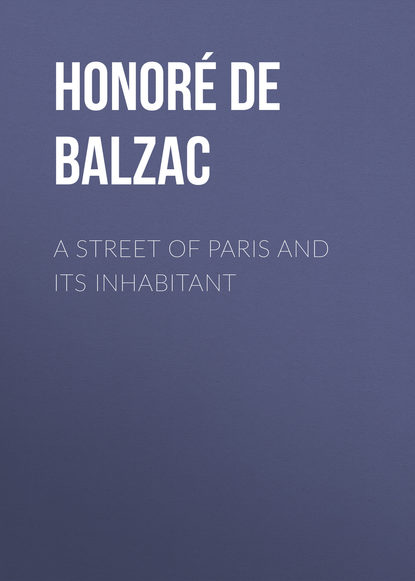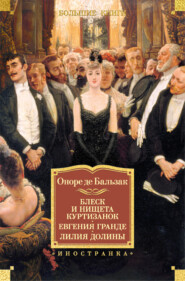По всем вопросам обращайтесь на: info@litportal.ru
(©) 2003-2024.
✖
A Street of Paris and Its Inhabitant
Настройки чтения
Размер шрифта
Высота строк
Поля
A Street of Paris and Its Inhabitant
Honoré Balzac
Honoré de Balzac
A Street of Paris and Its Inhabitant
PREFACE
This little Parisian silhouette in prose was written by Balzac to be the first chapter of a new series of the "Comedie Humaine" that he was preparing while the first was finishing. Balzac was never tired. He said that the men who were tired were those who rested and tried to work afterwards.
"A Street of Paris and its Inhabitant" was in its author's mind when Hetzel, engaged in collecting a copy for the work entitled "Le Diable a Paris" that all book lovers admire, asked Balzac for an unpublished manuscript.
Balzac gave him this, after retouching it, in order that it should have the air of a finished story. Why Hetzel did not use it in "Le Diable a Paris," no one knows. He went into exile, in Brussels, at the military revolution that made Napoleon III Emperor and, needing money, sold "A Street of Paris and its Inhabitant" with other manuscripts to Le Siecle.
Balzac's work was printed entire in three pages of the journal Le Siecle, in Paris, July 28, 1845. M. le Vicomte Spoelberch de Lovenjoul owns Balzac's autograph manuscript of it. These details are given by him and might be reproduced here with his signature. But the publishers wish not to be deprived of the pleasure of paying homage to the Vicomte Spoelberch de Lovenjoul.
He has made in the biography of Balzac, in editions of his books, in the pious collection of his unpublished writings, the ideal literary man's monument.
H. P. du B.
I
PHYSIOGNOMY OF THE STREET
Paris has curved streets, streets that are serpentine. It counts, perhaps, only the Rue Boudreau in the Chaussee d'Antin and the Rue Duguay-Trouin near the Luxembourg as streets shaped exactly like a T-square. The Rue Duguay-Trouin extends one of its two arms to the Rue d'Assas and the other to the Rue de Fleurus.
In 1827 the Rue Duguay-Trouin was paved neither on one side nor on the other; it was lighted neither at its angle nor at its ends. Perhaps it is not, even to-day, paved or lighted. In truth, this street has so few houses, or the houses are so modest, that one does not see them; the city's forgetfulness of them is explained, then, by their little importance.
Lack of solidity in the soil is a reason for that state of things. The street is situated on a point of the Catacombs so dangerous that a portion of the road disappeared recently, leaving an excavation to the astonished eyes of the scarce inhabitants of that corner of Paris.
A great clamor arose in the newspapers about it. The government corked up the "Fontis" – such is the name of that territorial bankruptcy – and the gardens that border the street, destitute of passers-by, were reassured the more easily because the tax list did not weigh on them.
The arm of the street that extends to the Rue de Fleurus is entirely occupied, at the left, by a wall on the top of which shine broken bottles and iron lances fixed in the plaster – a sort of warning to hands of lovers and of thieves.
In this wall is a door, the famous little garden door, so necessary to dramas and to novels, which is beginning to disappear from Paris.
This door, painted in dark green, having an invisible lock, and on which the tax collector had not yet painted a number; this wall, along which grow thistles and grass with beaded blades; this street, with furrows made by the wheels of wagons; other walls gray and crowned with foliage, are in harmony with the silence that reigns in the Luxembourg, in the convent of the Carmelites, in the gardens of the Rue de Fleurus.
If you went there, you would ask yourself, "Who can possibly live here?"
Who? Wait and see.
II
SILHOUETTE OF THE INHABITANT
One day, about three in the afternoon, that door was opened. Out of it came a little old man, fat, provided with an abdomen heavy and projecting which obliges him to make many sacrifices. He has to wear trousers excessively wide, not to be troubled in walking. He has renounced, long ago, the use of boots and trouser straps. He wears shoes. His shoes were hardly polished.
The waistcoat, incessantly impelled to the upper part of the gastric cavities by that great abdomen, and depressed by the weight of two thoracic bumps that would make the happiness of a thin woman, offers to the pleasantries of the passers-by a perfect resemblance to a napkin rolled on the knees of a guest absorbed in discussion at dessert.
The legs are thin, the arm is long, one of the hands is gloved only on most solemn occasions and the other hand ignores absolutely the advantage of a second skin.
That personage avoids the alms and the pity that his venerable green frock coat invites, by wearing the red ribbon at his button-hole. This proves the utility of the Order of the Legion of Honor which has been contested too much in the past ten years, the new Knights of the Order say.
The battered hat, in a constant state of horror in the places where a reddish fuzz endures, would not be picked up by a rag picker, if the little old man let it fall and left it at a street corner.
Too absent-minded to submit to the bother that the wearing of a wig entails, that man of science – he is a man of science – shows, when he makes a bow, a head that, viewed from the top, has the appearance of the Farnese Hercules's knee.
Above each ear, tufts of twisted white hair shine in the sun like the angry silken hairs of a boar at bay. The neck is athletic and recommends itself to the notice of caricaturists by an infinity of wrinkles, of furrows; by a dewlap faded but armed with darts in the fashion of thistles.
The constant state of the beard explains at once why the necktie, always crumpled and rolled by the gestures of a disquiet head, has its own beard, infinitely softer than that of the good old man, and formed of threads scratched from its unfortunate tissue.
Now, if you have divined the torso and the powerful back, you will know the sweet tempered face, somewhat pale, the blue ecstatic eyes and the inquisitive nose of that good old man, when you learn that, in the morning, wearing a silk head kerchief and tightened in a dressing-gown, the illustrious professor – he is a professor – resembled an old woman so much that a young man who came from the depths of Saxony, of Weimar, or of Prussia, expressly to see him, said to him, "Forgive me, Madame!" and withdrew.
This silhouette of one of the most learned and most venerated members of the Institute betrays so well enthusiasm for study and absent-mindedness caused by application to the quest of truth, that you must recognize in it the celebrated Professor Jean Nepomucene Apollodore Marmus de Saint-Leu, one of the most admirable men of genius of our time.
III
MADAME ADOLPHE
When the old man – the professor counted then sixty-two summers – had walked three steps, he turned his head at this question, hurled in an acute tone by a voice that he recognized:
"Have you a handkerchief?"
A woman stood on the step of the garden door and was watching her master with solicitude.
She seemed to be fifty years of age, and her dress indicated that she was one of those servants who are invested with full authority in household affairs.
She was darning stockings.
The man of science came back and said naively:
"Yes, Madame Adolphe, I have my handkerchief."
"Have you your spectacles?" she asked.
The man of science felt the side pocket of his waistcoat.
"I have them," he replied.
"Show them to me," she said. "Often you have only the case."
The professor took the case out of his pocket and showed the spectacles with a triumphant air.
"You would do well to keep them on your nose," she said.
M. de Saint-Leu put on his spectacles, after rubbing the glasses with his handkerchief.
Naturally, he thrust the handkerchief under his left arm while he set his spectacles on his nose. Then he walked a few steps towards the Rue de Fleurus and relaxed his hold on the handkerchief, which fell.
Honoré Balzac
Honoré de Balzac
A Street of Paris and Its Inhabitant
PREFACE
This little Parisian silhouette in prose was written by Balzac to be the first chapter of a new series of the "Comedie Humaine" that he was preparing while the first was finishing. Balzac was never tired. He said that the men who were tired were those who rested and tried to work afterwards.
"A Street of Paris and its Inhabitant" was in its author's mind when Hetzel, engaged in collecting a copy for the work entitled "Le Diable a Paris" that all book lovers admire, asked Balzac for an unpublished manuscript.
Balzac gave him this, after retouching it, in order that it should have the air of a finished story. Why Hetzel did not use it in "Le Diable a Paris," no one knows. He went into exile, in Brussels, at the military revolution that made Napoleon III Emperor and, needing money, sold "A Street of Paris and its Inhabitant" with other manuscripts to Le Siecle.
Balzac's work was printed entire in three pages of the journal Le Siecle, in Paris, July 28, 1845. M. le Vicomte Spoelberch de Lovenjoul owns Balzac's autograph manuscript of it. These details are given by him and might be reproduced here with his signature. But the publishers wish not to be deprived of the pleasure of paying homage to the Vicomte Spoelberch de Lovenjoul.
He has made in the biography of Balzac, in editions of his books, in the pious collection of his unpublished writings, the ideal literary man's monument.
H. P. du B.
I
PHYSIOGNOMY OF THE STREET
Paris has curved streets, streets that are serpentine. It counts, perhaps, only the Rue Boudreau in the Chaussee d'Antin and the Rue Duguay-Trouin near the Luxembourg as streets shaped exactly like a T-square. The Rue Duguay-Trouin extends one of its two arms to the Rue d'Assas and the other to the Rue de Fleurus.
In 1827 the Rue Duguay-Trouin was paved neither on one side nor on the other; it was lighted neither at its angle nor at its ends. Perhaps it is not, even to-day, paved or lighted. In truth, this street has so few houses, or the houses are so modest, that one does not see them; the city's forgetfulness of them is explained, then, by their little importance.
Lack of solidity in the soil is a reason for that state of things. The street is situated on a point of the Catacombs so dangerous that a portion of the road disappeared recently, leaving an excavation to the astonished eyes of the scarce inhabitants of that corner of Paris.
A great clamor arose in the newspapers about it. The government corked up the "Fontis" – such is the name of that territorial bankruptcy – and the gardens that border the street, destitute of passers-by, were reassured the more easily because the tax list did not weigh on them.
The arm of the street that extends to the Rue de Fleurus is entirely occupied, at the left, by a wall on the top of which shine broken bottles and iron lances fixed in the plaster – a sort of warning to hands of lovers and of thieves.
In this wall is a door, the famous little garden door, so necessary to dramas and to novels, which is beginning to disappear from Paris.
This door, painted in dark green, having an invisible lock, and on which the tax collector had not yet painted a number; this wall, along which grow thistles and grass with beaded blades; this street, with furrows made by the wheels of wagons; other walls gray and crowned with foliage, are in harmony with the silence that reigns in the Luxembourg, in the convent of the Carmelites, in the gardens of the Rue de Fleurus.
If you went there, you would ask yourself, "Who can possibly live here?"
Who? Wait and see.
II
SILHOUETTE OF THE INHABITANT
One day, about three in the afternoon, that door was opened. Out of it came a little old man, fat, provided with an abdomen heavy and projecting which obliges him to make many sacrifices. He has to wear trousers excessively wide, not to be troubled in walking. He has renounced, long ago, the use of boots and trouser straps. He wears shoes. His shoes were hardly polished.
The waistcoat, incessantly impelled to the upper part of the gastric cavities by that great abdomen, and depressed by the weight of two thoracic bumps that would make the happiness of a thin woman, offers to the pleasantries of the passers-by a perfect resemblance to a napkin rolled on the knees of a guest absorbed in discussion at dessert.
The legs are thin, the arm is long, one of the hands is gloved only on most solemn occasions and the other hand ignores absolutely the advantage of a second skin.
That personage avoids the alms and the pity that his venerable green frock coat invites, by wearing the red ribbon at his button-hole. This proves the utility of the Order of the Legion of Honor which has been contested too much in the past ten years, the new Knights of the Order say.
The battered hat, in a constant state of horror in the places where a reddish fuzz endures, would not be picked up by a rag picker, if the little old man let it fall and left it at a street corner.
Too absent-minded to submit to the bother that the wearing of a wig entails, that man of science – he is a man of science – shows, when he makes a bow, a head that, viewed from the top, has the appearance of the Farnese Hercules's knee.
Above each ear, tufts of twisted white hair shine in the sun like the angry silken hairs of a boar at bay. The neck is athletic and recommends itself to the notice of caricaturists by an infinity of wrinkles, of furrows; by a dewlap faded but armed with darts in the fashion of thistles.
The constant state of the beard explains at once why the necktie, always crumpled and rolled by the gestures of a disquiet head, has its own beard, infinitely softer than that of the good old man, and formed of threads scratched from its unfortunate tissue.
Now, if you have divined the torso and the powerful back, you will know the sweet tempered face, somewhat pale, the blue ecstatic eyes and the inquisitive nose of that good old man, when you learn that, in the morning, wearing a silk head kerchief and tightened in a dressing-gown, the illustrious professor – he is a professor – resembled an old woman so much that a young man who came from the depths of Saxony, of Weimar, or of Prussia, expressly to see him, said to him, "Forgive me, Madame!" and withdrew.
This silhouette of one of the most learned and most venerated members of the Institute betrays so well enthusiasm for study and absent-mindedness caused by application to the quest of truth, that you must recognize in it the celebrated Professor Jean Nepomucene Apollodore Marmus de Saint-Leu, one of the most admirable men of genius of our time.
III
MADAME ADOLPHE
When the old man – the professor counted then sixty-two summers – had walked three steps, he turned his head at this question, hurled in an acute tone by a voice that he recognized:
"Have you a handkerchief?"
A woman stood on the step of the garden door and was watching her master with solicitude.
She seemed to be fifty years of age, and her dress indicated that she was one of those servants who are invested with full authority in household affairs.
She was darning stockings.
The man of science came back and said naively:
"Yes, Madame Adolphe, I have my handkerchief."
"Have you your spectacles?" she asked.
The man of science felt the side pocket of his waistcoat.
"I have them," he replied.
"Show them to me," she said. "Often you have only the case."
The professor took the case out of his pocket and showed the spectacles with a triumphant air.
"You would do well to keep them on your nose," she said.
M. de Saint-Leu put on his spectacles, after rubbing the glasses with his handkerchief.
Naturally, he thrust the handkerchief under his left arm while he set his spectacles on his nose. Then he walked a few steps towards the Rue de Fleurus and relaxed his hold on the handkerchief, which fell.

















